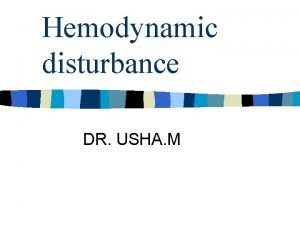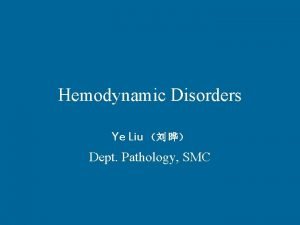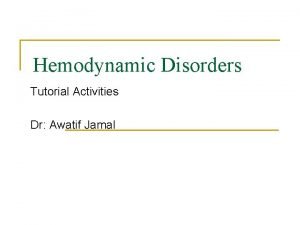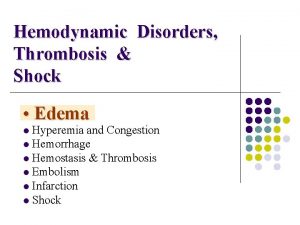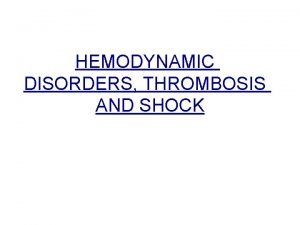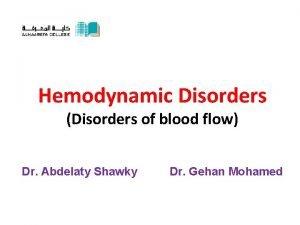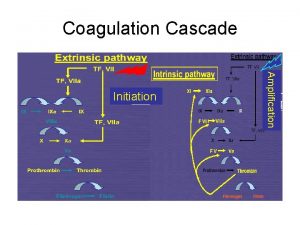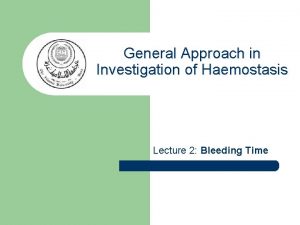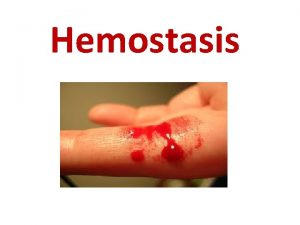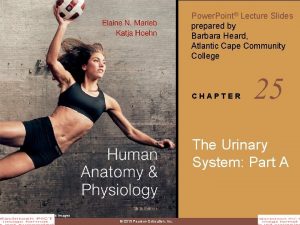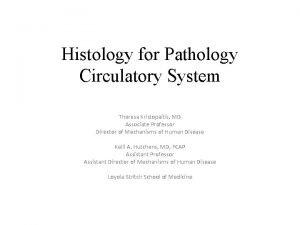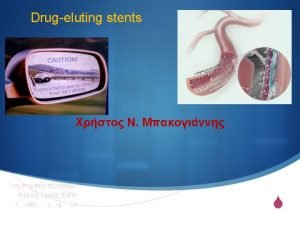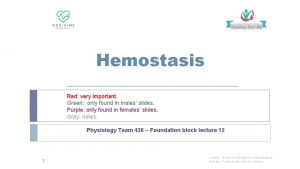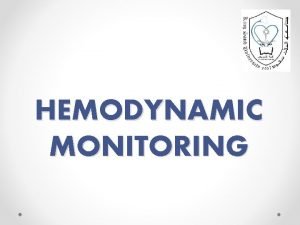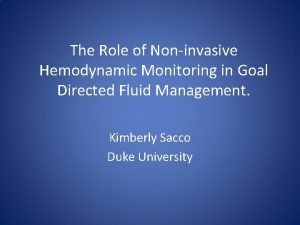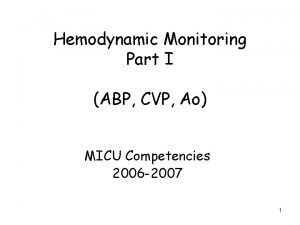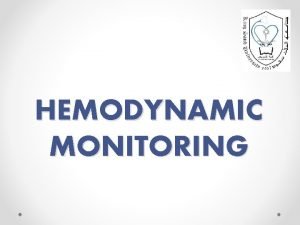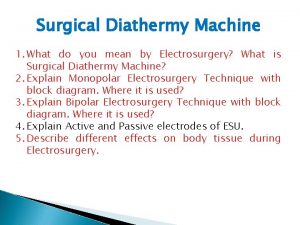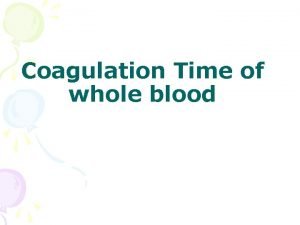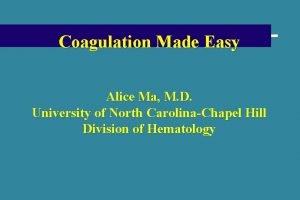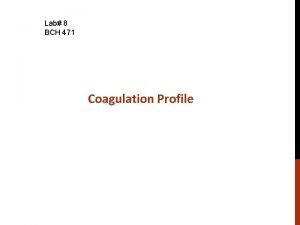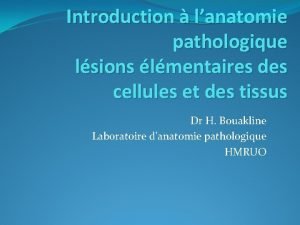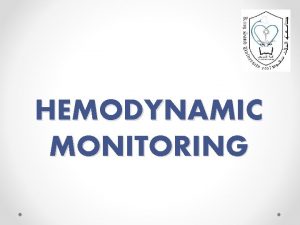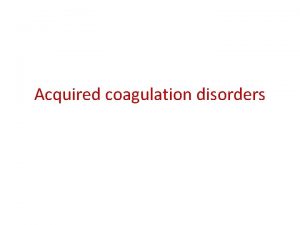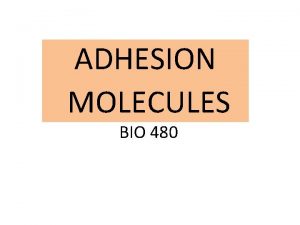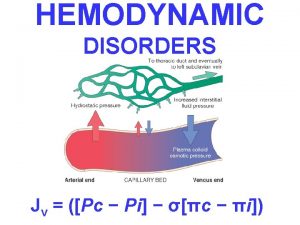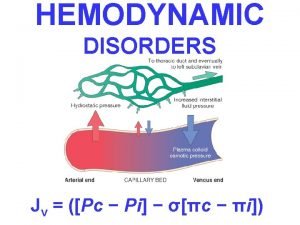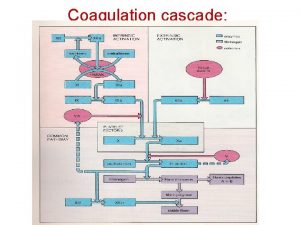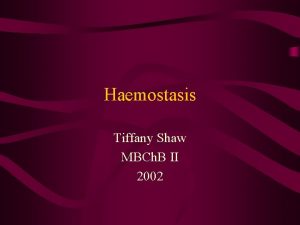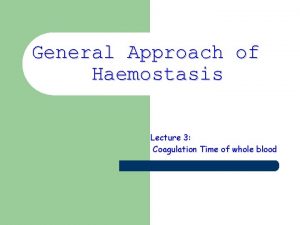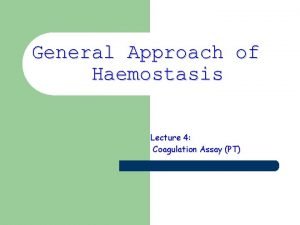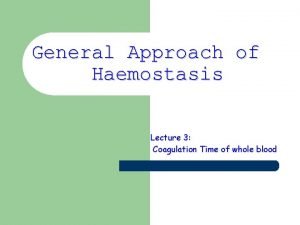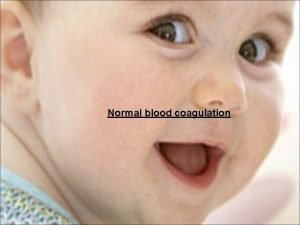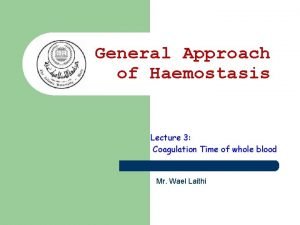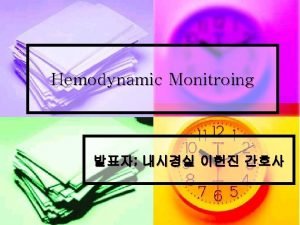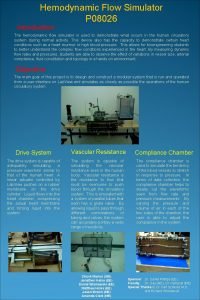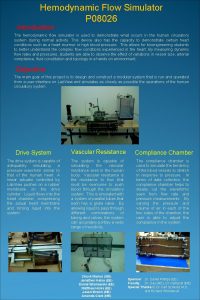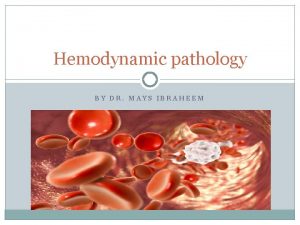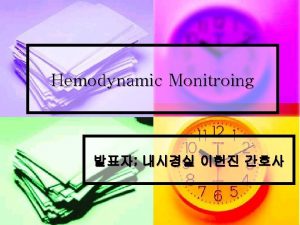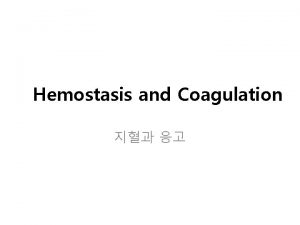Hemodynamic Disorders III Haemostasis coagulation factors and endothelium

























- Slides: 25

Hemodynamic Disorders III Haemostasis (coagulation factors and endothelium) Ghadeer Hayel, MD Histopathologist 1

Endothelium Platelets Clotting factors Clotting Hemostasis Bleeding Balance 2

Coagulation Cascade q It is a series of amplifying enzymatic reactions that lead to the deposition of an insoluble fibrin clot. q. In eash reaction step there is : an enzyme (an activated coagulation factor), a substrate (an inactive proenzyme form of a coagulation factor), and a cofactor (a reaction accelerator). q. These components are assembled on a negatively charged phospholipid surface, which is provided by activated platelets. q. Assembly of reaction complexes also depends on calcium, which binds to γ-carboxylated glutamic acid residues that are present in factors II, VII, IX, and X. q. The enzymatic reactions that produce γ-carboxylated glutamic acid use vitamin K as a cofactor. q. These reactions are antagonized by drugs such as Coumadin (warfarin), a widely used anticoagulant. 3

4

q Usually referred to by number (except prothrombin, Ca+2, TF and fibrinogen) q Numbers written as Roman numerals q 12 known procoagulants q Activated when collagen, tissue factor or negatively charged surfaces are exposed 5

Based on assays performed in clinical laboratories, the coagulation cascade has traditionally been divided into the extrinsic and intrinsic pathways The prothrombin time (PT) The partial thromboplastin time (PTT) Assess proteins in the extrinsic pathway (factors VII, X, V, II (prothrombin), and fibrinogen). Screens the function of the proteins in the intrinsic pathway (factors XII, XI, IX, VIII, X, V, II, and fibrinogen). tissue factor, phospholipids, and calcium are added to plasma and the time for a fibrin clot to form is recorded. addition of negative charged particles (e. g. , ground glass) that activate factor XII (Hageman factor) together with phospholipids and calcium. 6

7

8

9

Common pathway Extrinsic pathway Independent of VII Xa with V, Calcium and phospholipid convert prothrombin (II) to thrombin (IIa) “Prothrombinase complex” occurs on platelet surface Thrombin has many substrates both procoagulant ( positive feedback loop) and anticoagulant ( negative feedback) Precipitating event is exposure of tissue factor to blood Tissue factor is a membrane protein which acts as cofactor for VIIa Phospholipid, tissue factor and VIIa cleaves X Xa Contact activation of XII activates XI In lab =contact to negatively charged surfaces (kaolin, celite, silica) XIa activates IX IXa with VIII can activate X 10

11

• Deficiencies of factors V, VIII, IX, X and VII are associated with moderate to severe bleeding disorders. • Prothrombin deficiency is likely incompatible with life. • In contrast, factor XI deficiency is only associated with mild bleeding, and individuals with factor XII deficiency do not bleed and in fact may be susceptible to thrombosis. • Based on the effects of various factor deficiencies in humans, it is believed that, in vivo, factor VIIa/tissue factor complex is the most important activator of factor IX and that factor IXa/factor VIIIa complex is the most important activator of factor X. • The mild bleeding tendency seen in patients with factor XI deficiency is likely explained by the ability of thrombin to activate factor XI (as well as factors V and VIII), a feedback mechanism that amplifies the coagulation cascade. 12

https: //www. omicsonline. org/articles-images/2157 -7412 -S 1 -005 -g 001. html 13

Thrombin factor IIa Among the coagulation factors, thrombin is the most important, because its various enzymatic activities control diverse aspects of hemostasis and link clotting to inflammation and repair. 14

Among thrombin’s most important activities: • Conversion of fibrinogen into crosslinked fibrin monomers, directly, that polymerize into an insoluble fibril. • Amplifies the coagulation process, not only by activating factor XI, but also by activating two critical cofactors V and VIII. It also stabilizes the secondary hemostatic plug by activating factor XIII, which covalently crosslinks fibrin. • Platelet activation. Thrombin is a potent inducer of platelet activation and aggregation through its ability to activate PARs (protease-activated receptors) • Proinflammatory effects. PARs also are expressed on inflammatory cells, endothelium, & other cell types, so activation of these receptors mediate proinflammatory effects that contribute to tissue repair and angiogenesis. • Anti-coagulant effects: in normal endothelium, changes from a procoagulant to an anticoagulant (prevents clots from extending beyond the site of the vascular injury). 15

Factors That Limit Coagulation Once initiated, coagulation must be restricted to the site of vascular injury to prevent harmful consequences: + One limiting factor is simple dilution; blood flowing past the site of injury washes coagulation factors. + Second is the requirement for negatively charged phospholipids, mainly provided by platelets. 16

Cont. . Factors That Limit Coagulation + Activation od fibrinolytic cascade that limits the size of the clot & contributes to its later dissolution. plasmin: enzyme that breaks down fibrin & interferes with its polymerization. An elevated level of breakdown products of fibrinogen (fibrin split products mostly D-dimers) are a useful clinical markers of several thrombotic states. Plasmin is generated by enzymatic catabolism of the inactive circulating precursor plasminogen: + by a factor XII–dependent pathway ( Remember: XII deficiency & thrombosis) + or by plasminogen activators. The most important plasminogen activator is t-PA; it is synthesized principally by endothelium. • Fibrinolytic activity is largely confined to sites of recent thrombosis plasmin is tightly controlled by counter regulatory factors such as α 2 -plasmin inhibitor. 17

18

19

Endothelium + The balance between the anticoagulant & procoagulant activities of endothelium often determines whether clot formation, propagation, or dissolution occurs. + Normal endothelial cells express a multitude of factors that inhibit the procoagulant activities of platelets & coagulation factors & that augment fibrinolysis, they act in concert to prevent thrombosis & to limit clotting to sites of vascular damage. 20

The antithrombotic properties of endothelium: • Platelet inhibitory effects. + Intact endothelium serves as a barrier that shields platelets from subendothelial v. WF & collagen + Releases factors that inhibit platelet activation and aggregation; prostacyclin (PGI 2), nitric oxide (NO), and adenosine diphosphatase (degrades ADP) + Endothelial cells bind alter the activity of thrombin, which is one of the most potent activators of platelets. • Anticoagulant effects. + intact endothelium shields coagulation factors from tissue factor in vessel walls. + expresses multiple factors that actively oppose coagulation; thrombomodulin, endothelial protein C receptor, heparin-like molecules, and tissue factor pathway inhibitor. 21

+ Thrombomodulin and endothelial protein C receptor bind thrombin and protein C, respectively, in a complex on the endothelial cell surface. + thrombin loses its ability to activate coagulation factors and platelets. + thrombin cleaves & activates protein C instead, Protein C: a vitamin K–dependent protease that requires a cofactor protein S. +Activated protein C/protein S complex is a potent inhibitor of coagulation factors Va and VIIIa. 22

Cont. . The antithrombotic properties of endothelium: + Heparin-like molecules on endothelium surface bind activate antithrombin III, which then inhibits thrombin and factors IXa, XIa, and XIIa. The clinical utility of heparin and related drugs is based on their ability to stimulate antithrombin III activity. + Tissue factor pathway inhibitor (TFPI), like protein C, requires protein S as a cofactor, to bind and inhibit tissue factor/factor VIIa complexes. • Fibrinolytic effects. Normal endothelial cells synthesize t-PA, as a key component of the fibrinolytic pathway. 23

24

THANK YOU Insert Image 25
 Edema lesion
Edema lesion Hemodynamic disorders pathology
Hemodynamic disorders pathology Jamal gross
Jamal gross Edema heart
Edema heart Hemodynamic disorders
Hemodynamic disorders Difference between hyperemia and congestion
Difference between hyperemia and congestion Hemodynamic disorders
Hemodynamic disorders Coagulation disorders
Coagulation disorders The ivy method
The ivy method Haemostasis
Haemostasis Capillary endothelium
Capillary endothelium Endothelium
Endothelium Endothelial injury
Endothelial injury Hemostasis
Hemostasis Normal hemodynamic values
Normal hemodynamic values Proximal lumen
Proximal lumen Pinsky hemodynamic monitoring
Pinsky hemodynamic monitoring Hemodynamic monitoring system
Hemodynamic monitoring system Swan catheter
Swan catheter Hamlet act iii scene ii
Hamlet act iii scene ii Diathermy block diagram
Diathermy block diagram Disseminated intravascular coagulation pathophysiology
Disseminated intravascular coagulation pathophysiology Capillary glass tube method for clotting time
Capillary glass tube method for clotting time Coagulation made easy
Coagulation made easy Coagulation profile test
Coagulation profile test Idrosadenoide
Idrosadenoide
